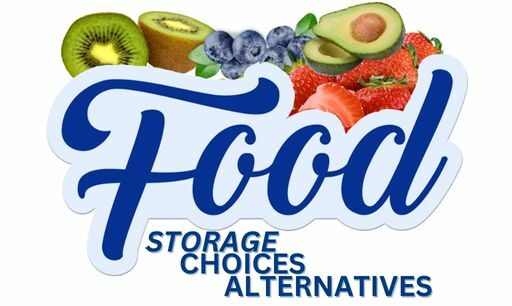Cod Alternatives: The 12 Best Substitutes
As a Certified Health Coach specializing in nutrition, many of my clients ask about types of fish and their alternatives. Even though cod is healthy, there is a few reasons why someone would want to find alternatives. Therefore, what fish are similar to cod?
The following are the best cod alternatives:
- Black cod
- Pollock
- Haddock
- Halibut
- Grouper
- Tilapia
- Silver Hake
- Striped bass
- Mahi mahi
- Gurnard
- Whiting
- Monkfish
This article will list each one and compare their tastes, textures and cooking methods. In addition, I’ll examine and include a side-by-side comparison of their nutrients.
In addition to coaching clients about them, I’ve purchased, researched and used the alternatives in this article prior to, during and after writing this article.
Cod Alternatives
1. Black Cod
Black cod is another name for sablefish but is not part of the cod fish family.
Why black cod is a good replacement for cod:
- Black cod provides more omega-3 fatty acids and B vitamins.
- It has a white flesh and black outside.
- Black cod may add more buttery flavor.
- It’s easy to find similar size fillets.
- Even though it contains more mercury it’s still listed as a good mercury choice.
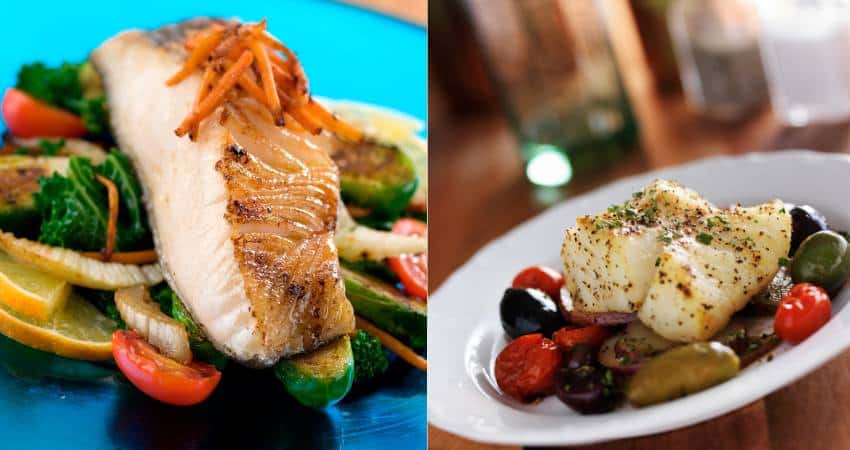
Cooking comparison:
- They can be cooked using similar methods like roasting, grilled, poached, broiled and fried.
- It can be cooked longer and doesn’t dry out as fast due to its higher fat content.
Macro comparison
The following table is a side-by-side comparison of some nutrients contained per 3 ounces.
| Cod, raw (3 ounces) | Black Cod, raw (3 ounces) | |
| Calories | 70 | 166 |
| Protein | 15.1 g | 11.4 g |
| Total fat | 0.57 g | 13.0 g |
| Omega-3 | 0.17 g | 1.33 g |
| Potassium | 351 mg | 304 mg |
| Calcium | 13.6 mg | 29.8 mg |
If you’re counting calories be aware black cod contains over twice the amount. I’ll purchase and cook black cod due to its omega-3 fatty acids.
2. Pollock
Why pollock is a good replacement:
- It provides more omega-3 fatty acids and minerals.
- Pollock’s flesh is a light color but not as white.
- It has a similar mild and non-fishy taste.
- Pollock costs less money.
- Pollock has similar mercury levels.
- It has similar calories per serving.
Cooking comparison:
- They can be cooked using similar methods like roasting, poached, broiled and fried.
- Cod’s texture is firmer and is better for grilling or searing.
- Pollock has as smaller flakes.
- Pollock is fattier and won’t dry out as easily.
Macro comparison
The following table is a side-by-side comparison of some nutrients contained per 3 ounces.
| Cod, raw (3 ounces) | Atlantic Pollock, raw (3 ounces) | |
| Calories | 70 | 78 |
| Protein | 15.1 g | 16.5 g |
| Total fat | 0.57 g | 0.82 g |
| Omega-3 | 0.17 g | 0.38 g |
| Potassium | 351 mg | 302 mg |
| Calcium | 13.6 mg | 51 mg |
Nutrient Resources3
This video shows you an easy way to cook Alaskan pollock.
3. Haddock
Why haddock is a good choice:
- It has slightly fewer calories.
- Haddock’s flesh is white and similar.
- Haddock’s flavor is less mild but not over powering.
- Haddock costs are similar.
- It has similar mercury levels.
Cooking comparison:
- If grilling, haddock isn’t a good substitute because the flesh falls apart easily.
- Cod’s texture is firmer and is better for grilling or searing.
- They can be cooked using other methods like baking, poached, broiled and fried.
- Haddock has smaller flakes.
- Haddock fillets are mostly smaller.
- Haddock cooks quicker.
Macro comparison
The following table is a side-by-side comparison of some nutrients contained per 3 ounces.
| Cod, raw (3 ounces) | Haddock, raw (3 ounces) | |
| Calories | 70 | 63 |
| Protein | 15.1 g | 14.2 g |
| Total fat | 0.57 g | 0.38 g |
| Omega-3 | 0.17 g | 0.12 g |
| Potassium | 351 mg | 243 mg |
| Calcium | 13.6 mg | 9.3 mg |
Nutrient Resources4
I’ll often eat haddock as an option due to its mild flavor and omega-3s.
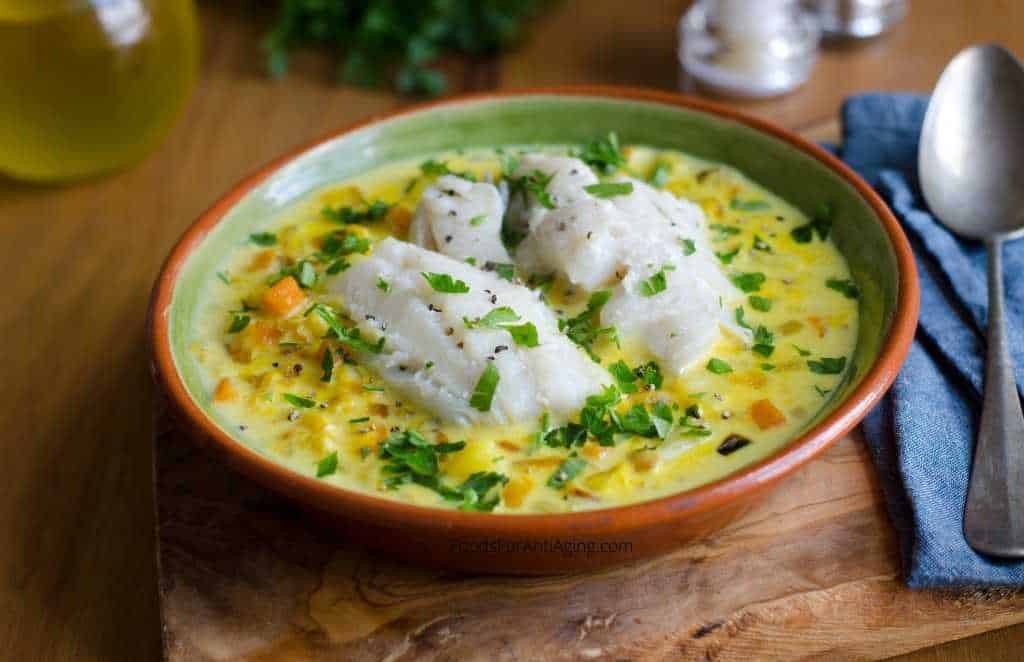
4. Halibut
Why halibut is a good option:
- Halibut has a similar number of calories.
- Both have a similar mild taste and firm texture.
- Its flesh is light colored and similar.
Cooking comparison:
- Halibut is typically a thicker cut of fish so using the same size fillet is easy.
- They can be cooked using the same cooking methods like searing, roasting, grilling, baking, poached, broiled and fried.
- Halibut has smaller flakes.
Macro comparison
The following table is a side-by-side comparison of some nutrients contained per 3 ounces.
| Cod, raw (3 ounces) | Halibut, raw (3 ounces) | |
| Calories | 70 | 77 |
| Protein | 15.1 g | 15.8 g |
| Total fat | 0.57 g | 1.13 g |
| Omega-3 | 0.17 g | 0.18 g |
| Potassium | 351 mg | 370 mg |
| Calcium | 13.6 mg | 5.9 mg |
Nutrient Resources5
The first time I tried halibut, I knew I found my favorite out of the whole bunch.
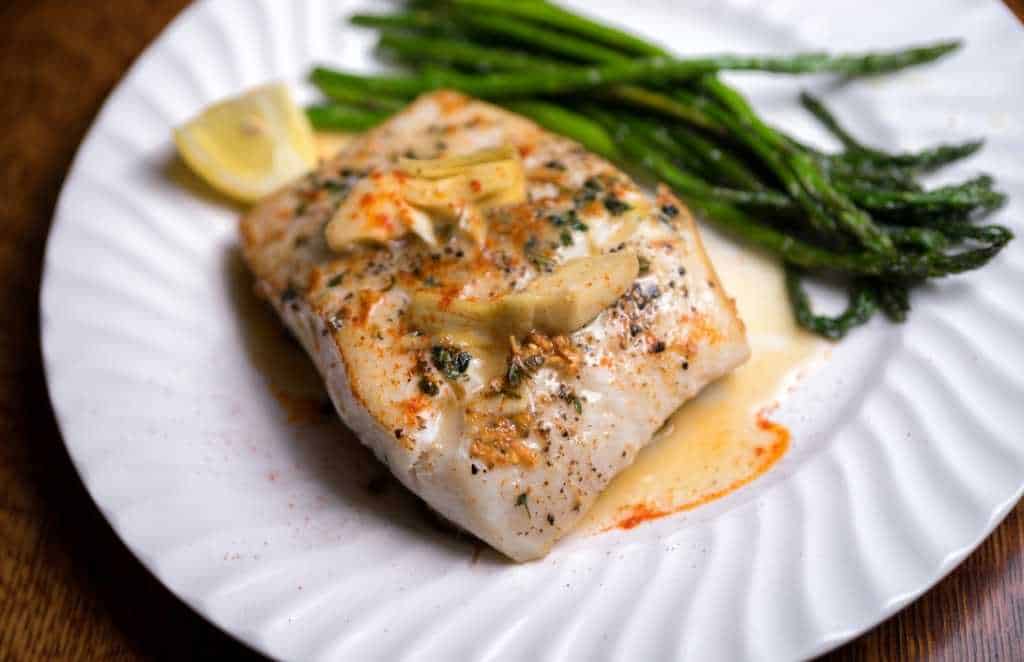
5. Red Grouper
Why red grouper is a good alternative:
- Red grouper has a mild flavor and firm texture similar to cod.
- It has large flakes.
- Red grouper’s flesh is light colored and similar.
- Red grouper is nutrient dense.
Cooking comparison:
- Red grouper is more difficult to overcook.
- Expect smaller fillets because red grouper is a smaller fish.
- Less cooking time for red grouper.
- They can be cooked using the same methods like grilling, searing, roasting, baking, broiled, poached and fried.
Macro comparison
The following table is a side-by-side comparison of some nutrients contained per 3 ounces.
| Cod, raw (3 ounces) | Grouper, raw (3 ounces) | |
| Calories | 70 | 78 |
| Protein | 15.1 g | 16.5 g |
| Total fat | 0.57 g | 0.86 g |
| Omega-3 | 0.17 g | 0.22 g |
| Potassium | 351 mg | 411 mg |
| Calcium | 13.6 mg | 23 mg |
Nutrient Resources6
Although red grouper is smaller, I like using it when it’s available. During my time on the west coast of Florida, I found grouper everywhere on menus.
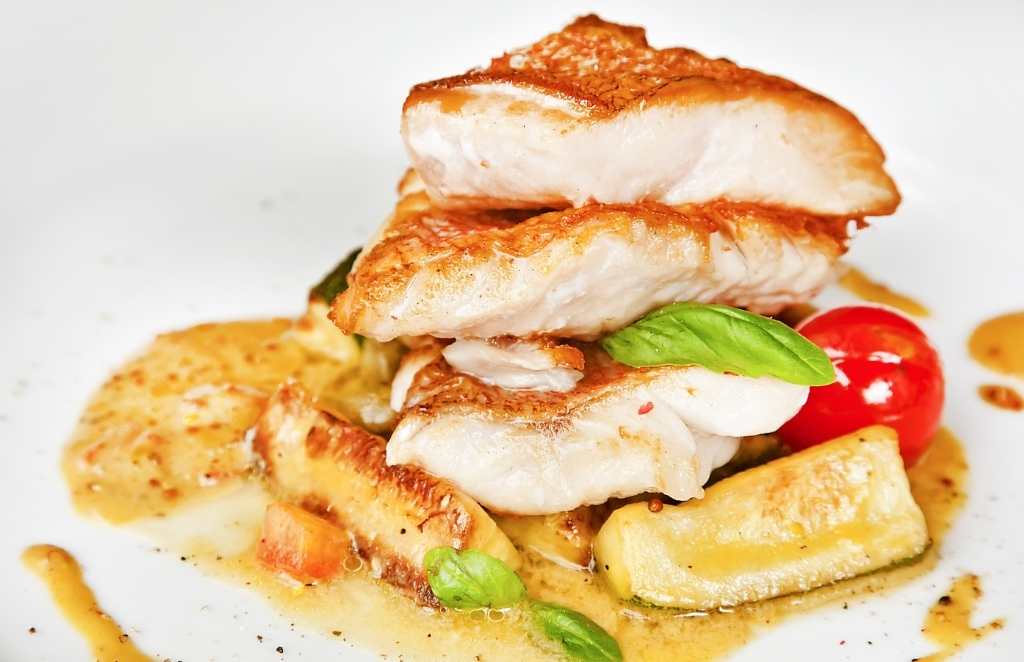
6. Tilapia
Why tilapia is a good option:
- Both have a similar mild taste and is not fishy.
- Tilapia’s flesh is light colored.
- It costs less money.
- Tilapia has a similar amount of mercury.
Cooking comparison:
- Tilapia can be cooked in recipes using the same cooking methods.
- Tilapia is more tender and may fall apart easier.
- Tilapia fillets are smaller.
Macro comparison
The following table is a side-by-side comparison of some nutrients contained per 3 ounces.
| Cod, raw (3 ounces) | Tilapia, raw (3 ounces) | |
| Calories | 70 | 82 |
| Protein | 15.1 g | 17.2 g |
| Total fat | 0.57 g | 1.42 g |
| Omega-3 | 0.17 g | 0.15 g |
| Potassium | 351 mg | 256 mg |
| Calcium | 13.6 mg | 8.5 mg |
Nutrient Resources7
I’ll eat tilapia often due to its availability.
The following video will inform you how to make pan fried tilapia.
7. Silver Hake
Hake is a term for a number of species related to cod.
Why hake is a good replacement:
- It has a similar flavor and texture.
- Hake’s flesh is light colored.
Cooking comparison:
- Expect smaller fillets when using hake.
- Hake will cook faster.
- Hake holds up well and the same cooking methods can be used like grilling, searing, roasting, baking, broiled, poached and fried.
Macro comparison
The following table is a side-by-side comparison of some nutrients contained per 3 ounces.
| Cod, raw (3 ounces) | Hake, raw (3 ounces) | |
| Calories | 70 | 77 |
| Protein | 15.1 g | 16 g |
| Total fat | 0.57 g | 1.10 g |
| Omega-3 | 0.17 g | 0.21 g |
| Potassium | 351 mg | 212 mg |
| Calcium | 13.6 mg | 41 mg |
Nutrient Resources8
8. Striped Bass
Why striped bass is a good option:
- Striped bass has a similar mild, non-fishy taste.
- Its flesh is light colored and flaky.
- Both have large flakes.
- Striped bass is close in size and weight.
Cooking comparison:
- Striped bass can be cooked using the same cooking methods.
- Both have similar sized fillets.
Macro comparison
The following table is a side-by-side comparison of some nutrients contained per 3 ounces.
| Cod, raw (3 ounces) | Striped Bass, raw (3 ounces) | |
| Calories | 70 | 82 |
| Protein | 15.1 g | 15.0 g |
| Total fat | 0.57 g | 1.98 g |
| Omega-3 | 0.17 g | 0.64 g |
| Potassium | 351 mg | 218 mg |
| Calcium | 13.6 mg | 12.8 mg |
Nutrient Resources9
Striped bass is both a freshwater fish and saltwater.
The video below will teach you a great way to cook striped bass for your recipes.
Find out what fish are good options for sea bass in my article, Sea Bass Substitutes: 10 Healthy Alternatives.
9. Mahi Mahi
Why mahi mahi is a good choice:
- Mahi mahi has a similar mild taste. The darker area will have a fishier taste.
- Both fish have a lighter colored flesh.
- Both have large flakes.
Cooking comparison:
- Mahi mahi can be cooked in recipes using the same cooking methods like baking, grilling, roasting, poaching and frying.
- Finding or trimming similar size fillets is easy.
- Trim away the darker area to get rid of the fishier taste.
Macro comparison
The following table is a side-by-side comparison of some nutrients contained per 3 ounces.
| Cod, raw (3 ounces) | Mahi mahi, raw (3 ounces) | |
| Calories | 70 | 72 |
| Protein | 15.1 g | 15.7 g |
| Total fat | 0.57 g | 0.60 g |
| Omega-3 | 0.17 g | 0.10 g |
| Potassium | 351 mg | 353 mg |
| Calcium | 13.6 mg | 12.8 mg |
Nutrient Resources10
Check out the best choices for trout in my article, Trout Replacements: The 12 Best Healthy Substitutes.
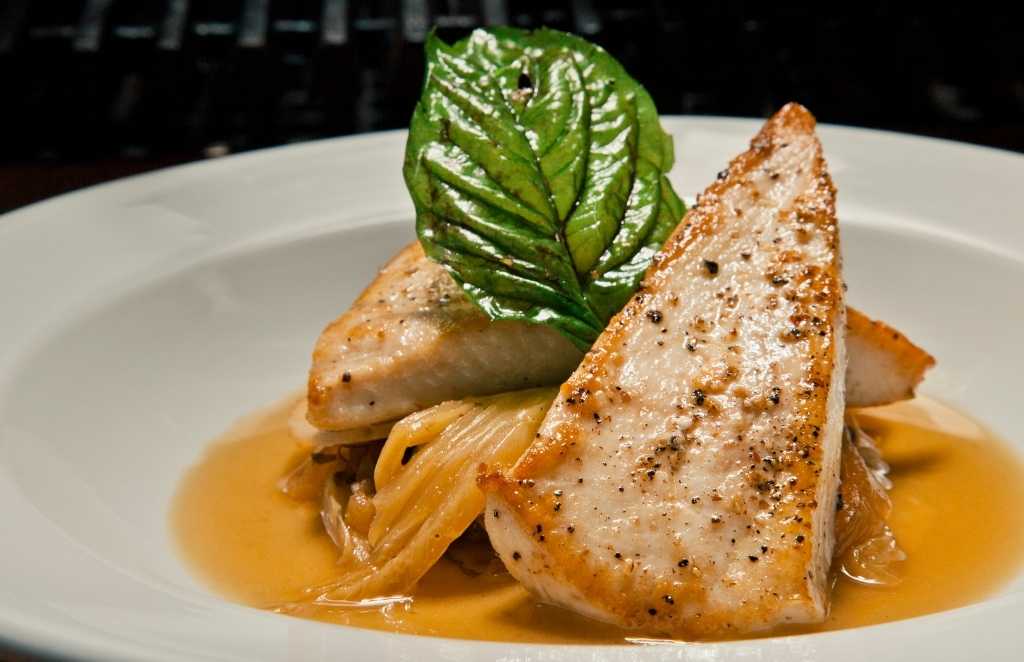
10. Gurnard
Why gurnard made the list:
- It has a mild flavor and firm texture.
- Gurnard’s flesh is light colored.
Cooking comparison:
- Expect smaller fillets because gurnard is a smaller fish.
- Less cooking time for gurnard.
- Gurnard can be cooked using the same cooking methods like grilling, searing, roasting, baking, broiled, poached and fried.
11. Whiting
Why whiting is an option:
- Whiting has a mild flavor and soft but firm texture.
- Both fish have a lighter colored flesh.
Cooking comparison:
- Whiting can be cooked in recipes using the same cooking methods like baking, grilling, roasting, poaching and frying.
- The texture may become mushy if it’s cooked at the incorrect temperature or length of time.
Macro comparison
The following table is a side-by-side comparison of some nutrients contained per 3 ounces.
| Cod, raw (3 ounces) | Whiting, raw (3 ounces) | |
| Calories | 70 | 77 |
| Protein | 15.1 g | 16 g |
| Total fat | 0.57 g | 1.10 g |
| Omega-3 | 0.17 g | 0.21 g |
| Potassium | 351 mg | 212 mg |
| Calcium | 13.6 mg | 41 mg |
Nutrient Resources11
I like to use it as another choice due to its mild flavor.
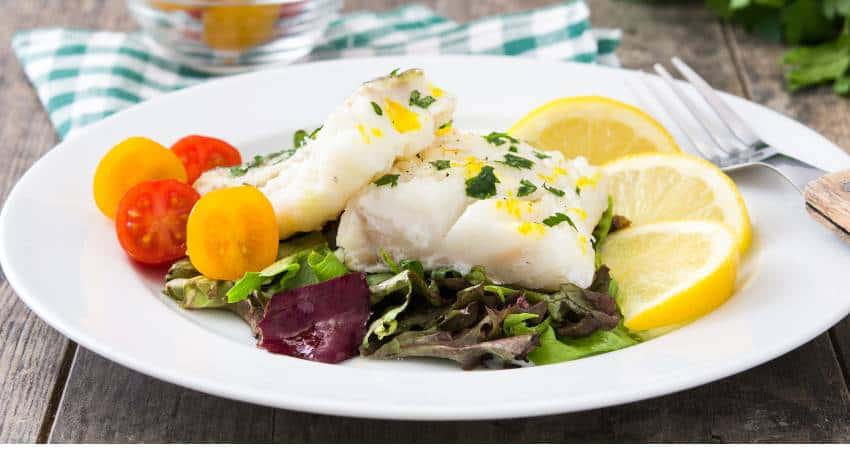
12. Monkfish
Why monkfish is on the list:
- It has a mild flavor and non-fishy taste.
- Monkfish flesh has a similar light color.
- It has a firm texture and holds together well.
- Finding larger fillets is easy.
Cooking comparison:
- Monkfish can be cooked using the same cooking methods.
- Monkfish will hold together better and is better for slow cooking.
Macro comparison
The following table is a side-by-side comparison of some nutrients contained per 3 ounces.
| Cod, raw (3 ounces) | Monkfish, raw (3 ounces) | |
| Calories | 70 | 64 |
| Protein | 15.1 g | 12.3 g |
| Total fat | 0.57 g | 1.29 g |
| Omega-3 | 0.17 g | 0.22 g |
| Potassium | 351 mg | 340 mg |
| Calcium | 13.6 mg | 6.8 mg |
Nutrient Resources12
Cod Fish Poll
To conduct some original research and get the opinions of real people like you, I polled my readers, clients and members of some food groups. I asked them what was the best cod alternative for you to buy?
- 30% said the best one was halibut which was the winner of the poll.
- 12% said red grouper which came in 2nd place.
- 8% said tilapia which came in 3rd place.
If you have any questions or legitimate interest about this article don’t hesitate to email us. You can find an email on our contact page.
Read Next – More Cod Articles!
Sea Bass vs Cod – Is One Better? Let’s Compare
Pacific Cod vs Atlantic Cod – What’s The Difference?
Pacific Cod vs Sockeye (Pacific Salmon) Which Is Better?
Alaska Pollock Vs Cod: A Comparison – Which Is Better?
Cod Vs Tilapia – A Complete Comparison
- USDA: Fish, sablefish, raw [↩]
- USDA: Fish, cod, Atlantic, raw [↩]
- USDA: Fish, pollock, raw [↩]
- USDA: Fish, haddock, raw [↩]
- USDA: Fish, halibut, Atlantic and Pacific, raw [↩]
- USDA: Fish, grouper, mixed species, raw [↩]
- USDA: Fish, tilapia, raw [↩]
- USDA: Hake Steaks [↩]
- USDA: Fish, bass, striped, raw [↩]
- Nutrition Value: Fish, raw, mahimahi [↩]
- Nutrition Value: Fish, raw, mixed species, whiting [↩]
- USDA: Fish, monkfish, raw [↩]
